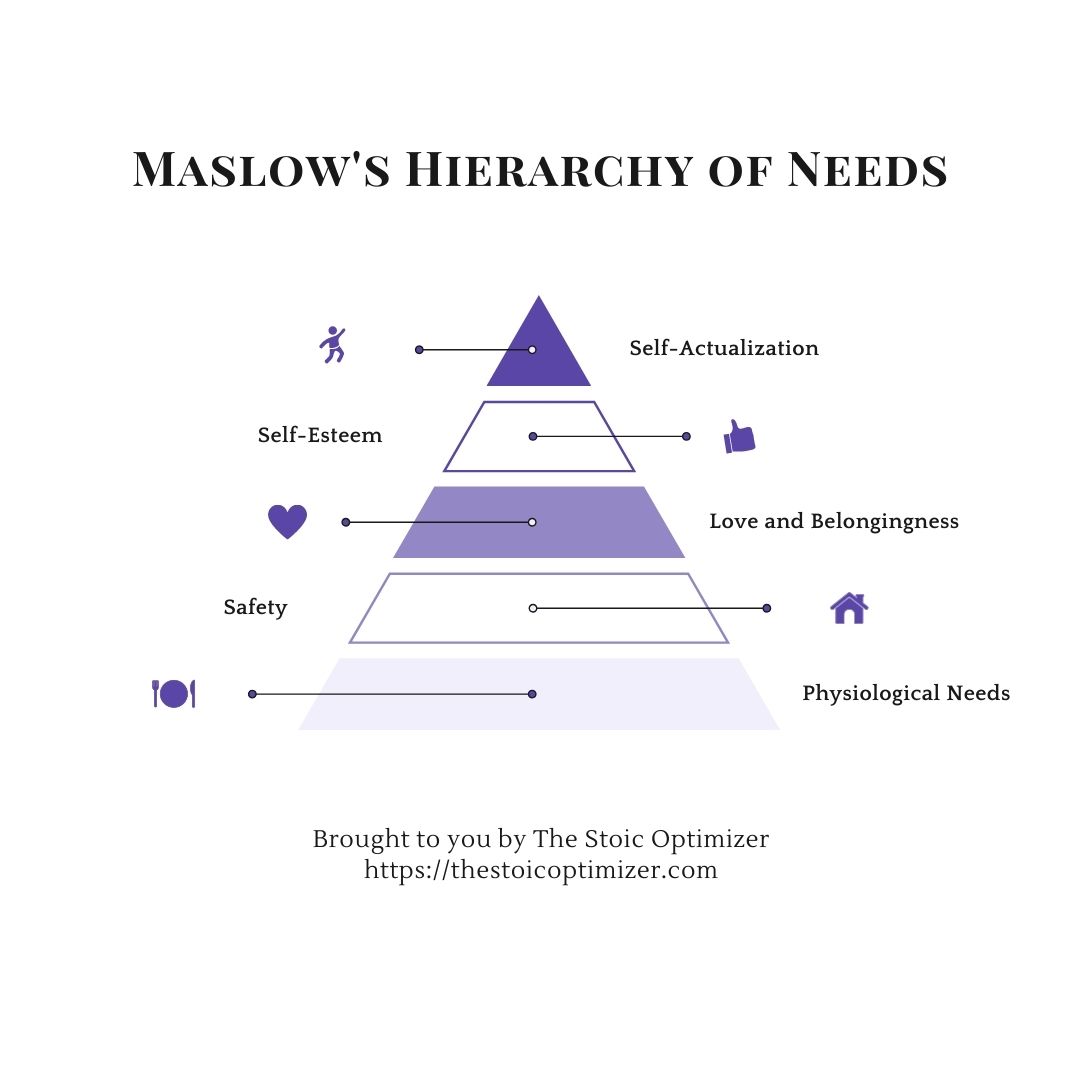What Is Maslow's Hierarchy of Needs?
If you've ever wondered what motivates people to act the way they do, a famous psychologist named Abraham Maslow might have a few pointers for you.
He believed that there are 5 levels of human needs that drive behavior - from basic ones such as the need for food and shelter, to more complex ones such as the need for love and fulfilment.
He argued that the lower levels are prerequisites for the highest, which he called self-actualization, which is just a fancy word for finding (and fulfilling) your purpose.
He firmly believed that humans are naturally drawn to achieving their true potential, so let's dive into the 5 levels of the pyramid & see how they apply to self-improvement.

What Are the 5 Levels of Maslow's Hierarchy of Needs?
Looking upwards from the base of the pyramid to its top, the 5 needs identified by Maslow are physiological needs, safety, love & belongingness, self-esteem and self-actualization.
This order is not random and suggests that the pyramid would collapse if the lower levels are precarious. Some of these needs are non-negotiable - as anyone who has been hungry or sleep deprived has noticed - while others tend to be more robust, allowing one to pursue the upper needs even if the lower one has not been met completely. If you'd rather watch a video explaining them, try either this one or this one, but do come back to see my actionable tips and key takeaways from Maslow's pyramid.
Physiological Needs
The first set of needs are the most basic and are shared by other animals as well. They ensure the survival of the individual (and more broadly, of the species) and tend to occupy our minds completely when they are not met.
What falls into this category? Hunger, thirst, the need for sleep and all other bodily functions. To put it concisely, everything that keeps a person in homeostasis.
Safety
Once the physiological needs are met, the individual seeks shelter. This is the need that spurs in us the desire for a literal "roof over one's head", but also a figurative one. It also explains why we seem to have more peace of mind when we have secured stable employment, have a savings account and buy insurance. From this level onward, needs fall on a spectrum: the definition of safety is somewhat fluid and varies from one individual to another, while hunger doesn't really leave any room for interpretation.
Love & Belongingness
The third need in the hierarchy pertains to the human as a social animal. It propels us not only to pursue a partner, but also instills in us the desire to be around friends and family; to belong to groups of people with similar characteristics and interests.
A word of warning, though: this need is not met unless love flows in both directions. According to Maslow, every individual wishes to be loved and accepted, but also to feel love for others.
Self-Esteem
Once an individual has satisfied his or her lower level necessities, needs pertaining to the self start to surface. The first of these is the longing for self-esteem (and self-confidence as a by-product of it) and for one's efforts to be recognized by others. This drive manifests as the need to feel like what we do is useful and valuable to the world.
Self-Actualization
Having gained the respect of others, the individual turns inward and begins to seek their higher purpose. It may not seem like there is a big difference between this level and the previous one, so here is what distinguishes them: there are multiple things we do (and which we are good at!) which are valuable to the world, but don't feel like a calling. If your grandmother would define self-actualization, she'd say it's "the thing you've been put on this earth to do".
Since this is the pinnacle of human endeavors - the level we all strive to climb up to - it warrants a longer discussion. Keep reading to learn how you can (efficiently!) apply Maslow's theory to reach your true purpose.
Distinguishing Between Deficiency & Growth Needs
Maslow used the term "deficiency" needs to describe the 4 lowest levels of the pyramid, while self-actualization is deemed a "growth" need. This dichotomy is based on how fulfilling these needs affects motivation - once the deficiency is gone, the motivation to pursue the need also disappears, while in the case of the growth needs, satisfying the need only serves to increase the appetite. Failing to fulfil the growth needs comes without dire side-effects, but ignoring the deficiency needs puts us in danger.
Self-Actualization - Yet Another Lofty Goal?
If you remember a single thing from this post, let it be this: Maslow and I believe in you. Each and every person is capable of reaching self-actualization (finding their purpose), they just need to trust themselves and ensure that their lower-level needs are reasonably met before they start chasing their purpose. So let's look at some actionable tips on how you can apply Maslow's theory to improve your own life.
The Essence of Maslow's Theory & How You Can Apply It
Self-development need not be devoid of efficiency. You're not superior if you struggle; measure your worth based on how much you've done to ensure your win (even if the result is ultimately out of your control), not how much you've toiled. (A.K.A.: Work smart, not hard.) I've written about this before.
Maslow's theory is important for us Stoic Optimizers because it serves as a roadmap of possible obstacles on our path to reaching our best selves. Even if you don't agree with the pyramid in its entirety, the underlying principle is intuitive enough to be useful: there is a set of necessary (but not sufficient) conditions that need to be fulfilled before you are free to focus on your purpose.
This doesn't mean you can't start working on what fulfils you most, it just means you shouldn't neglect the prerequisites because they will make your journey needlessly difficult.
Here is a heuristic for dealing with the hierarchy of needs:
Imagine that there is an hourglass attached to each level of the pyramid. When the sand runs out, the need takes center stage in your mind.
Any action you do to fulfil the need of that particular level resets the hourglass and gives you respite to work on the others. Depending on how well you automate and create systems for the base of the pyramid, the hourglass might deplete faster (in the absence of a system) or infinitely slower (when the needs are addressed for the long-term).
Let me explain: if you make dinner today, you've solved that physiological need for a few hours, so maybe if you're not too tired from doing the dishes afterwards, you'll read a book. If you meal prep on Sundays, the need is met for an entire week, leaving more bandwidth for you to work on yourself. If you're in a position to hire someone to bring you food at set hours of the day (without having to decide what to eat for every meal in the moment!), you've potentially solved it forever and thus gained all of that time back.
Actionable Tips Based on Maslow's Pyramid of Needs
Remember - this is a marathon, not a sprint. Start where you are and optimize from there; don't beat yourself up if you can't immediately create the perfect environment that meets all your needs leaving you to focus only on self-actualization.
It would be wonderful if we could spend every minute working on our passion, but that's not how we're built. Don't be discouraged by these inherent setbacks - every little improvement compounds. Most people aren't even aware of their prerequisite needs - you're miles ahead since you've decided to double down on them.
If you found this post useful, you might want to explore another popular topic from the Human Bugs & Features category. How about this post about the self-serving bias?

